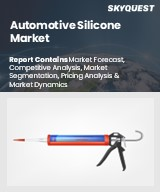
자동차용 실리콘 세계 시장 규모는 2023년에 15억 달러, 2024년 16억 달러에서 2032년에는 27억 1,000만 달러로 성장하고, 예측 기간(2025-2032년) CAGR은 6.8%를 나타낼 전망입니다.
자동차 산업은 엄격한 환경 규제에 대응하기 위해 연료 소비와 이산화탄소 배출량을 줄이기 위해 점점 더 많은 노력을 기울이고 있습니다. 자동차 성능을 향상시키기 위해 제조업체는 더 무거운 재료를 가벼운 대체 재료로 대체하고 있으며, 그 중에서도 실리콘은 높은 지지를 받고 있습니다. 실리콘의 우수한 내열성, 내구성 및 유연성은 개스킷, 씰 및 코팅에 이상적이며, 이는 연비를 향상시키고 전기자동차(EV)의 배터리 수명을 연장시킵니다. 또한, 실리콘의 내후성과 수명은 유지보수 비용을 절감하고 지속가능성을 추구하는 자동차 제조업체에게 어필할 수 있습니다. 친환경에 대한 지지가 증가함에 따라 자동차에 실리콘 솔루션의 채택이 크게 증가하여 차세대 모빌리티에 필수적인 부품이 되어 EV의 수명을 연장하는 데 필수적인 요소로 자리 잡았습니다.
Global Automotive Silicone Market size was valued at USD 1.5 billion in 2023 and is poised to grow from USD 1.6 billion in 2024 to USD 2.71 billion by 2032, growing at a CAGR of 6.8% during the forecast period (2025-2032).
The automotive industry is increasingly focusing on reducing fuel consumption and carbon emissions in response to stringent environmental regulations. To enhance vehicle performance, manufacturers are replacing heavier materials with lightweight alternatives, with silicone emerging as a highly favored option. Its exceptional heat resistance, durability, and flexibility make it ideal for gaskets, seals, and coatings, thereby improving fuel efficiency and extending battery life in electric vehicles (EVs). Additionally, silicone's weather resistance and longevity reduce maintenance costs, appealing to automakers aiming for sustainability. As support for environmentally friendly initiatives grows, the adoption of silicone solutions in vehicles is set to rise significantly, making it a vital component for next-generation mobility and an essential factor in increasing the lifespan of EVs.
Top-down and bottom-up approaches were used to estimate and validate the size of the Global Automotive Silicone market and to estimate the size of various other dependent submarkets. The research methodology used to estimate the market size includes the following details: The key players in the market were identified through secondary research, and their market shares in the respective regions were determined through primary and secondary research. This entire procedure includes the study of the annual and financial reports of the top market players and extensive interviews for key insights from industry leaders such as CEOs, VPs, directors, and marketing executives. All percentage shares split, and breakdowns were determined using secondary sources and verified through Primary sources. All possible parameters that affect the markets covered in this research study have been accounted for, viewed in extensive detail, verified through primary research, and analyzed to get the final quantitative and qualitative data.
Global Automotive Silicone Market Segments Analysis
Global Automotive Silicone Market is segmented by Product Type, Application, Vehicle Type, Form and region. Based on Product Type, the market is segmented into Silicone Fluids, Silicone Gels, Silicone Rubber, Silicone Emulsions and Others. Based on Application, the market is segmented into Sealing and Gaskets, Lubricants and Greases, Electrical and Electronics, Adhesives and Coatings and Others. Based on Vehicle Type, the market is segmented into Passenger Cars, Commercial Vehicles and Two-wheelers. Based on Form, the market is segmented into Liquid and Solid. Based on region, the market is segmented into North America, Europe, Asia Pacific, Latin America and Middle East & Africa.
Driver of the Global Automotive Silicone Market
The global automotive silicone market is significantly propelled by the ongoing shift towards electric vehicles (EVs). Silicone materials play a vital role in various applications, including battery thermal management, high-voltage insulation, and the development of lightweight components. As governments emphasize the importance of reducing emissions and enhancing energy efficiency, there is a growing demand for durable, heat-resistant silicone solutions. This trend not only supports the automotive industry's sustainability goals but also drives innovation and technological advancements, further fueling the expansion of the silicone market within the automotive sector.
Restraints in the Global Automotive Silicone Market
The global automotive silicone market faces significant challenges due to its close ties with the automotive industry's overall performance. Economic downturns, declining vehicle sales, and reduced consumer spending directly impact automotive production, consequently affecting the demand for silicone components. These fluctuating market conditions create obstacles for manufacturers, making it challenging to maintain consistent growth, secure investments, and pursue innovation within silicone technology. As a result, the market is hindered by these restraints, which can stifle advancements and limit the potential for expansion in the automotive silicone sector.
Market Trends of the Global Automotive Silicone Market
The Global Automotive Silicone market is witnessing a significant trend toward sustainability, driven by increasing environmental concerns and regulatory pressures. Manufacturers are actively developing eco-friendly, bio-based silicone substitutes while investing in low-emission production techniques to align with stringent environmental standards. This shift reflects the automotive industry's broader commitment to reducing environmental impact, as automotive companies seek greener alternatives to enhance efficiency and minimize carbon footprints in vehicle production. As a result, the market is evolving, with a growing demand for recyclable silicone products that not only meet regulatory requirements but also appeal to environmentally conscious consumers.